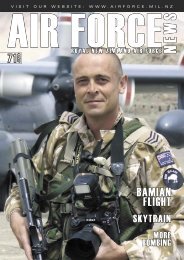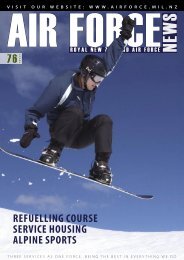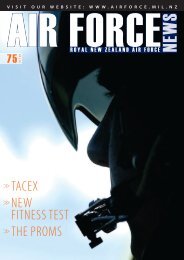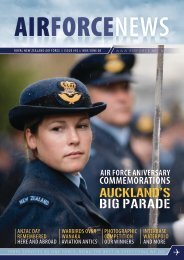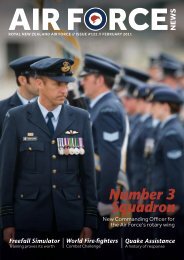ANNIVeRSARY AIR SHow! - Royal New Zealand Air Force
ANNIVeRSARY AIR SHow! - Royal New Zealand Air Force
ANNIVeRSARY AIR SHow! - Royal New Zealand Air Force
Create successful ePaper yourself
Turn your PDF publications into a flip-book with our unique Google optimized e-Paper software.
Antarctica seen from<br />
a c-130 cockpit<br />
E! it<br />
engineers will be busy loading and pre-flighting the aircraft for<br />
the trip while the pilots and navigator receive a weather brief<br />
from an American forecaster via a web cam. The Navigator will<br />
then start plotting fuel graphs and calculating a point of no<br />
return based on the winds and cargo/fuel load, while the pilots<br />
examine airfield conditions and complete flight plans.<br />
This is a critical part of the planning stage as the c-130<br />
cannot carry enough fuel to make it all the way to Antarctica<br />
(about an 8 hour flight)—and return home with cargo onboard.<br />
Thus there is a point along the way that if we proceed past,<br />
there is no turning back! As there are minimal options, if the<br />
weather turns for the worse or the runway becomes unusable<br />
for any reason, it is important that the decision to continue<br />
is well thought out and made with as much information as<br />
possible.<br />
It is for this reason that Antarctica flights are considered<br />
by some to be the most dangerous flying No. 40 Sqn<br />
undertakes—Antarctic weather can be extremely fickle.<br />
Some trips will be conducted as a ‘down and back’. At<br />
McMurdo we remain on the ground only for as long as it takes<br />
to offload and refuel. These can be long days for all involved,<br />
when you take into account getting up at 0430, fly for 8 hours,<br />
add turn around times, fly for 8 hours more, and then clear<br />
customs once home.<br />
crew duty limitations often play a large part in planning the<br />
day. on some trips the crew will stay the night down there,<br />
usually in the American base at McMurdo. This provides other<br />
challenges that come from leaving the aircraft exposed for<br />
is an amazing experience to be<br />
able to fly to the most remote<br />
continent on earth<br />
Pre-flight preparations at McMurdo, note<br />
the hot air being piped into No. 3 engine<br />
an extended period in sub-zero temperatures. we operate a<br />
cold weather checklist and change our procedures to reduce<br />
damage to the aircraft from thermal shock [ie. rapid changes<br />
of temperature on the aircrafts systems] and to conserve the<br />
fragile ice runway. You can appreciate that the pre-flight takes<br />
a bit longer, when you have to carve massive chunks of ice off<br />
the aircraft!<br />
There are many challenges with flying to the ice, and the<br />
conditions for landing can change quickly. Some days it is<br />
absolutely breathtaking—clear blue skies, pristine snowcovered<br />
mountains, and not a breath of wind. other times<br />
there are strong winds kicking up snow and reducing visibility.<br />
That makes things tricky for a crosswind landing on a runway<br />
made of ice!<br />
we conduct our ice flights each year to not only help out<br />
with the delivery of supplies and equipment to the scientific<br />
teams down there, but also to keep up our training and<br />
procedures for when they are needed in a hurry. This could be<br />
in the form of a medical evacuation or a rescue mission, such<br />
as the airdrop of pumps and equipment to the damaged fishing<br />
vessel SPARTA [see AFN 133 February]. This year we made five<br />
scheduled flights to McMurdo, plus two to assist the SPARTA.<br />
I know that anyone’s first trip to Antarctica is memorable;<br />
mine certainly was. It is a wonderful experience to stand and<br />
see this so-untouched land. Although the days are long and the<br />
conditions sometimes tricky it is an amazing experience to be<br />
able to fly to the most remote continent on earth.<br />
<strong>Air</strong> <strong>Force</strong> news 15



![February 2007, Issue 78 [pdf 3mb, 44 pages] - Royal New Zealand ...](https://img.yumpu.com/17485296/1/184x260/february-2007-issue-78-pdf-3mb-44-pages-royal-new-zealand-.jpg?quality=85)
